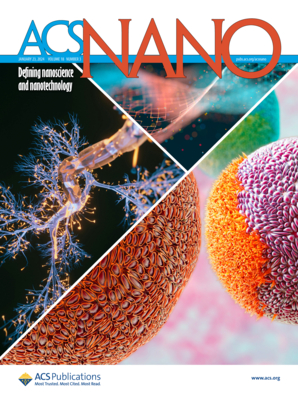One-Dimensional Electron Gas Confined along Nanowrinkles in a Unidirectional Charge Density Wave Material
IF 15.8
1区 材料科学
Q1 CHEMISTRY, MULTIDISCIPLINARY
引用次数: 0
Abstract
Two-dimensional (2D) materials inherently exhibit instabilities. Structurally, this may lead to modulations along the third dimension, e.g., wrinkles. Electronically, 2D instabilities can manifest themselves as charge density waves (CDWs). Although wrinkles can alter anisotropic electronic structures susceptible to forming CDWs, less is known about their impact on broken-symmetry ground states. Here, using scanning tunneling microscopy and spectroscopy, we investigate the CDW states on the wrinkled surface of DyTe3. We identify elongated, parallel nanoscale wrinkles stabilized by ribbon-shaped defects. Interestingly, the CDW order persists across the nanowrinkles with a gradual phase shift but is locally suppressed near the defects, where phase windings occur. In addition, these defects induce quantum confinement effects along the nanowrinkles, indicating the presence of one-dimensional metallic states with hole-like dispersion, while angle-resolved photoemission spectroscopy identifies a gap along the wrinkle direction. We ascribe this discrepancy to strain-induced changes in the Fermi surface, which lead to the closure of the gap at the sites of the nanowrinkles. Taken together, our results underscore the complex interplay between structural features and Fermi surface topology, allowing for the deliberate manipulation of quantum states in strongly correlated systems via local crystal deformations.

求助全文
约1分钟内获得全文
求助全文
来源期刊

ACS Nano
工程技术-材料科学:综合
CiteScore
26.00
自引率
4.10%
发文量
1627
审稿时长
1.7 months
期刊介绍:
ACS Nano, published monthly, serves as an international forum for comprehensive articles on nanoscience and nanotechnology research at the intersections of chemistry, biology, materials science, physics, and engineering. The journal fosters communication among scientists in these communities, facilitating collaboration, new research opportunities, and advancements through discoveries. ACS Nano covers synthesis, assembly, characterization, theory, and simulation of nanostructures, nanobiotechnology, nanofabrication, methods and tools for nanoscience and nanotechnology, and self- and directed-assembly. Alongside original research articles, it offers thorough reviews, perspectives on cutting-edge research, and discussions envisioning the future of nanoscience and nanotechnology.
 求助内容:
求助内容: 应助结果提醒方式:
应助结果提醒方式:


